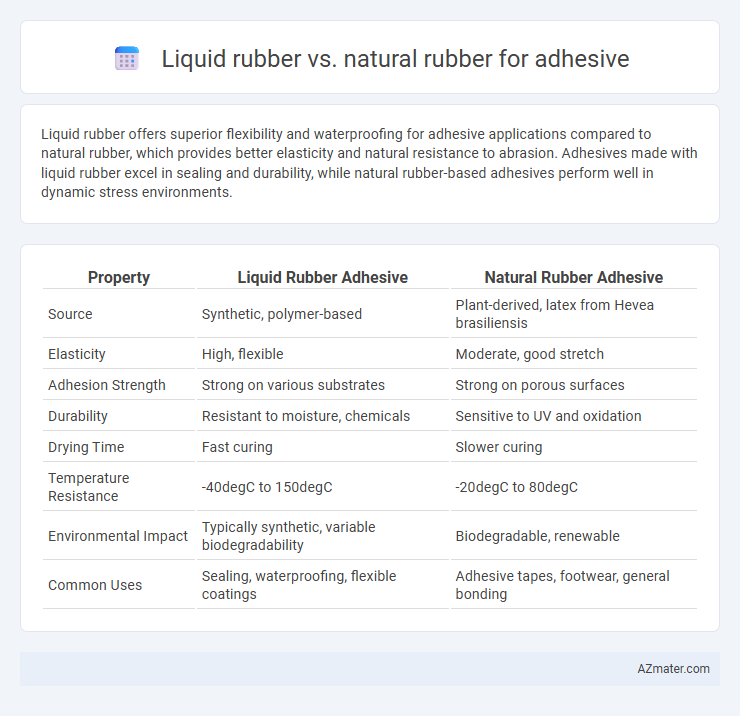Liquid rubber offers superior flexibility and waterproofing for adhesive applications compared to natural rubber, which provides better elasticity and natural resistance to abrasion. Adhesives made with liquid rubber excel in sealing and durability, while natural rubber-based adhesives perform well in dynamic stress environments.
Table of Comparison
| Property | Liquid Rubber Adhesive | Natural Rubber Adhesive |
|---|---|---|
| Source | Synthetic, polymer-based | Plant-derived, latex from Hevea brasiliensis |
| Elasticity | High, flexible | Moderate, good stretch |
| Adhesion Strength | Strong on various substrates | Strong on porous surfaces |
| Durability | Resistant to moisture, chemicals | Sensitive to UV and oxidation |
| Drying Time | Fast curing | Slower curing |
| Temperature Resistance | -40degC to 150degC | -20degC to 80degC |
| Environmental Impact | Typically synthetic, variable biodegradability | Biodegradable, renewable |
| Common Uses | Sealing, waterproofing, flexible coatings | Adhesive tapes, footwear, general bonding |
Introduction to Liquid Rubber and Natural Rubber
Liquid rubber offers superior elasticity and water resistance, making it an ideal adhesive for flexible materials and waterproof applications. Natural rubber, derived from latex of rubber trees, provides strong tackiness and excellent durability, commonly used in traditional adhesive formulations. Both materials excel in adhesion but differ in chemical composition and environmental resilience, influencing their specific industrial uses.
Chemical Composition: Liquid vs Natural Rubber
Liquid rubber typically consists of synthetic polymers like styrene-butadiene or nitrile, offering enhanced consistency and customizable properties for adhesives. Natural rubber, derived from latex of the Hevea brasiliensis tree, is primarily composed of cis-1,4-polyisoprene, which provides high elasticity and tensile strength but less chemical resistance. The chemical composition of liquid rubber allows for superior resistance to environmental factors and better adhesion to diverse substrates compared to the naturally occurring polymers in natural rubber.
Adhesive Performance Comparison
Liquid rubber adhesives exhibit superior flexibility and environmental resistance compared to natural rubber, making them ideal for applications requiring durability under varying temperatures and moisture conditions. Natural rubber adhesives offer excellent initial tack and strong bonding strength on porous surfaces but tend to degrade faster when exposed to UV light and ozone. Performance tests show liquid rubber adhesives maintain adhesion and elasticity over time, outperforming natural rubber in long-term durability and chemical resistance.
Bonding Strength and Durability
Liquid rubber adhesives offer superior bonding strength compared to natural rubber, providing a more consistent and flexible bond that resists cracking and peeling over time. Natural rubber adhesives, while effective for temporary or light-duty applications, tend to degrade faster under UV exposure, moisture, and temperature fluctuations. In terms of durability, liquid rubber adhesives maintain elasticity and adhesion properties longer, making them ideal for industrial and outdoor uses where long-lasting performance is critical.
Flexibility and Elasticity in Adhesive Applications
Liquid rubber exhibits superior flexibility compared to natural rubber, allowing adhesives to maintain strong bonds on dynamic or curved surfaces without cracking. Its enhanced elasticity ensures better elongation and recovery, crucial for applications requiring repeated stretching or movement. Natural rubber, while elastic, tends to lose flexibility over time when exposed to heat and chemicals, limiting its adhesive performance in demanding conditions.
Resistance to Environmental Factors
Liquid rubber adhesives exhibit superior resistance to environmental factors such as UV radiation, moisture, and temperature fluctuations compared to natural rubber adhesives. The synthetic polymers in liquid rubber create a more durable, flexible barrier that withstands harsh weather conditions and chemical exposure. Natural rubber adhesives tend to degrade faster under prolonged exposure to ozone and heat, reducing their effectiveness in outdoor and industrial applications.
Ease of Application and Curing Time
Liquid rubber offers superior ease of application compared to natural rubber adhesives due to its fluid consistency, allowing smooth spreading and filling of complex surfaces without the need for special tools. It typically cures faster, often within minutes to a few hours, enhancing productivity in industrial and DIY projects. In contrast, natural rubber adhesives require longer curing times and more meticulous application techniques to achieve optimal adhesion and flexibility.
Cost Efficiency and Availability
Liquid rubber offers significant cost efficiency due to its ease of application and minimal waste, making it ideal for large-scale adhesive projects. Natural rubber, while providing excellent elasticity and bonding strength, often incurs higher costs linked to extraction and processing, limiting its availability. The widespread production of synthetic liquid rubber ensures consistent supply and competitive pricing compared to the more variable availability of natural rubber adhesives.
Ideal Use Cases and Industry Preferences
Liquid rubber adhesives offer superior flexibility and chemical resistance, making them ideal for automotive seals, waterproofing applications, and electronic device encapsulation where durability under stress is critical. Natural rubber adhesives excel in applications requiring high initial tack and elasticity, such as footwear manufacturing, packaging, and general-purpose bonding in the construction industry. Industries favor liquid rubber for waterproofing and protective coatings while choosing natural rubber for adhesive tapes and flexible bonding due to its natural polymer properties and cost-effectiveness.
Conclusion: Choosing the Right Rubber Adhesive
Liquid rubber offers superior flexibility, water resistance, and easy application, making it ideal for sealing and waterproofing tasks. Natural rubber provides excellent elasticity and strong bonding properties, suited for applications requiring durable elasticity and high tensile strength. Selecting the right rubber adhesive depends on the specific requirements of the project, such as environmental exposure, flexibility needs, and bonding strength to ensure optimal performance.

Infographic: Liquid rubber vs Natural rubber for Adhesive
 azmater.com
azmater.com